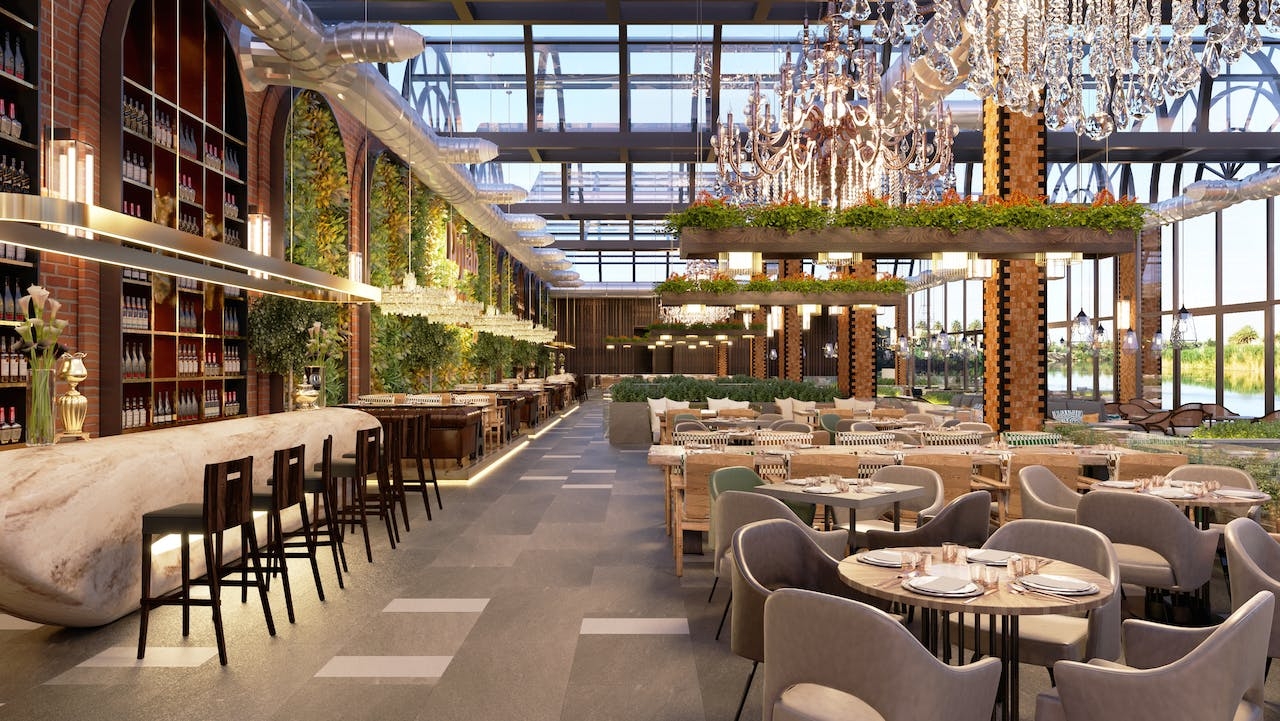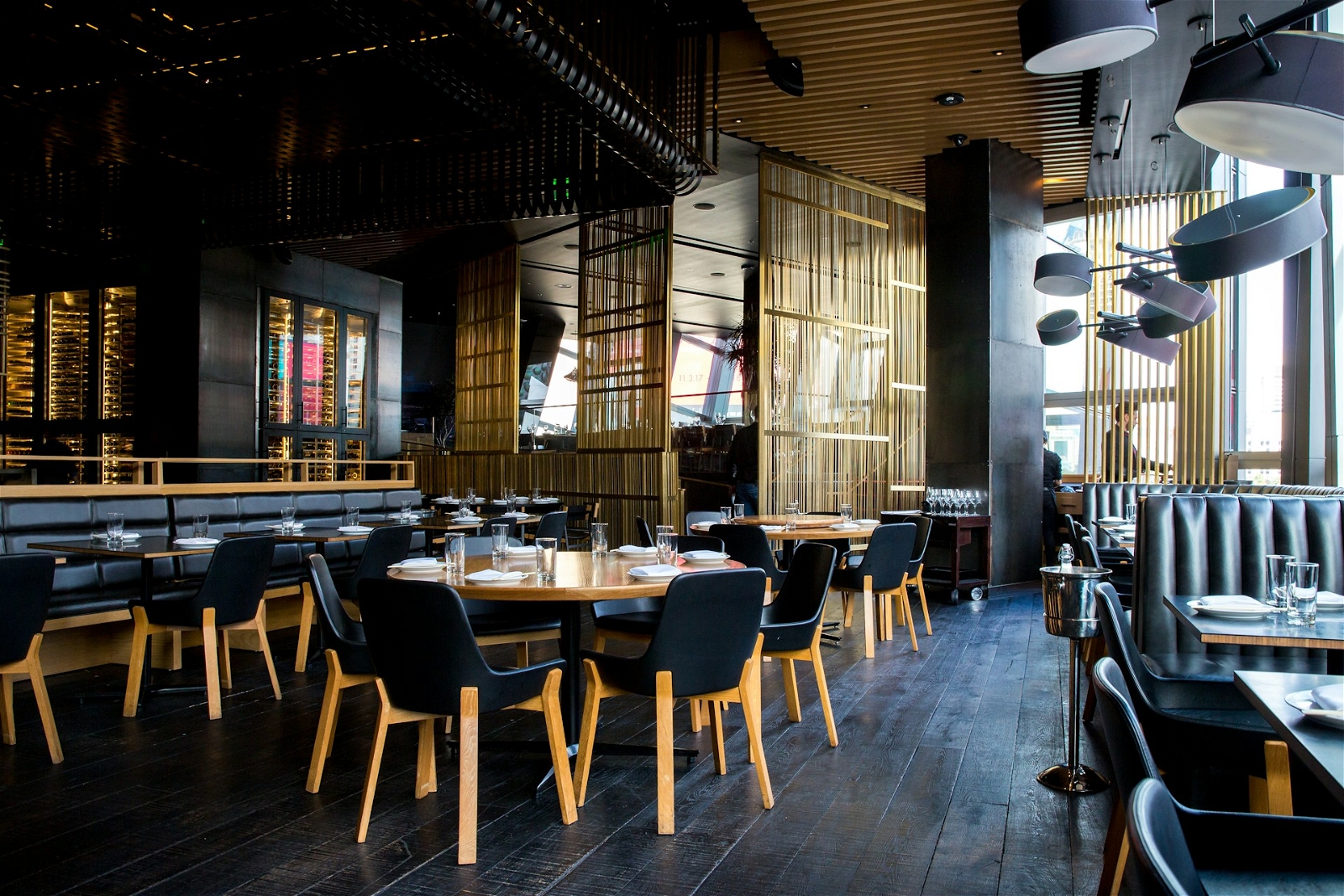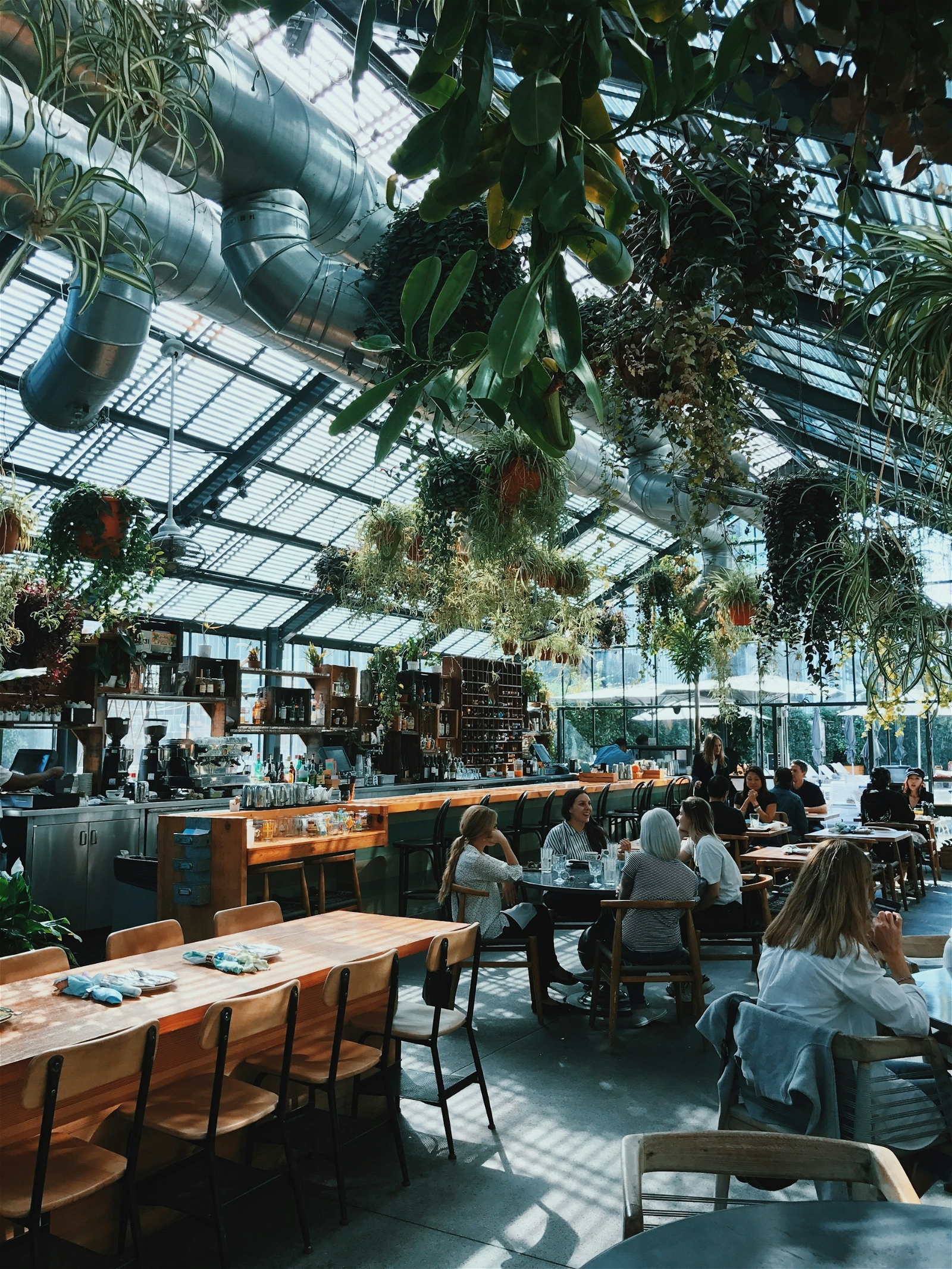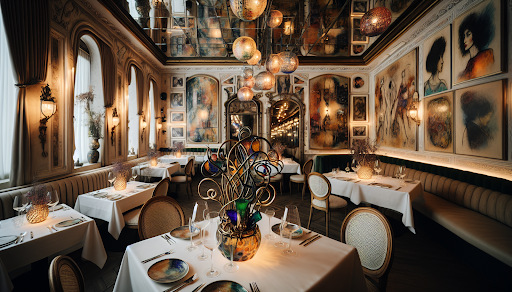Top Trends in Restaurant Interior Design for a Stunning Dining Experience
By Anttoni Taimela · 1. February 2024
The right restaurant interior design can transform a good meal into an immersive experience, leaving a lasting impression on diners.
Exploring essential design elements, this article offers you the inside scoop on creating a space that is as delectable for the eyes as your cuisine is for the palate.
Dive in to discover how your restaurant can stand out and attract more patrons.
Key Takeaways
- A restaurant’s color palette, lighting, and acoustics aren’t just for show; they set the stage for an emotionally resonant dining experience – talk about love at first sight (and bite)!
- Furniture isn’t just about posterior comfort; it’s a central piece of the dining story, with tables, chairs, counters, and bar stools all playing crucial roles in the culinary narrative.
- Blurring the lines between interior design and fine dining, a restaurant’s layout, incorporation of natural elements, and curated art pieces can turn a meal into an immersive adventure.
Creating a Welcoming Atmosphere in Your Restaurant
 restaurant interior
restaurant interior
Ever walked into a restaurant and felt an immediate sense of warmth and comfort?
That’s the magic of a well-designed ambiance.
Creating a welcoming atmosphere is like serving a delectable appetizer, enticing guests to stay for the main course.
With a well-thought-out color palette, strategic lighting, and harmonious acoustics, restaurants can create an inviting environment that elevates the dining experience.
Here are the key considerations when creating a captivating ambiance.
Choosing the Right Color Palette
Choosing the right color palette for your restaurant is like selecting the perfect ingredients for a gourmet dish.
The colors you choose can stir emotions and set the tone for the dining experience.
Vibrant colors can evoke energy and creativity, while softer, warmer hues can create a cozy, inviting atmosphere.
Choosing the perfect color palette requires understanding your restaurant’s concept and target audience, selecting colors that mirror this identity.
Lighting for Mood and Functionality
Just as a perfectly placed chandelier can set the tone in a dining room, the right lighting in a restaurant can also create a distinctive mood.
However, lighting does more than just set the ambiance. It has a functional role, too, guiding customers’ movements and highlighting the restaurant’s best features.
From illuminating the vibrant colors of the interior design to casting a warm glow on simple furniture, lighting is the unsung hero that transforms a restaurant’s interior from ordinary to extraordinary.
Music and Acoustic Considerations
Now, let’s not forget the power of music in creating the perfect restaurant ambiance.
Ever noticed how the right tune can enhance your dining experience?
Well, it’s no accident! Music sets the pace of dining, can potentially boost sales, and is an essential ingredient in the overall restaurant decor.
The selection of the right soundtrack, matching the restaurant’s theme and aligning with guest preferences, is crucial.
So next time you’re at your favorite restaurant, pay attention to the music – it’s part of the whole culinary symphony!
The Art of Restaurant Furniture Selection
 pop up restaurant
pop up restaurant
Moving onto the main course, let’s talk about furniture.
The restaurant industry has made an art out of selecting furniture that not only complements the overall decor but also enhances the dining experience.
Just like how a well-cooked meal leaves a lasting impression, well-chosen restaurant furniture can also make a significant impact on the customers’ dining experience.
Uncover how tables, seating, bar stools, and counters can amplify the dining experience and mirror the restaurant’s style.
Tables and Seating That Enhance Dining
Choosing the right tables and seating for your restaurant is akin to setting the table for a fine dining experience.
The size, shape, and layout of tables can influence social interactions and customer behavior, and the right seating arrangements can turn a dull dining experience into a delightful one.
The objective is to strike the ideal balance of style, comfort, and functionality, enhancing dining and offering guests an unforgettable culinary journey.
Bar Stools and Counters as Focal Points
Now, let’s not overlook the importance of bar stools and counters in a restaurant.
These elements can be designed to steal the spotlight, offering plenty of seating options and blending in with the overall design.
Whether it’s a cozy corner bar in a modern restaurant or a large, centralized counter in a bustling café, the right bar stools and counters can create a dynamic and inviting atmosphere, encouraging guests to relax, socialize, and enjoy their dining experience.
Outdoor Dining Furniture Options
When it comes to outdoor dining, the perfect furniture can transform an open space into an inviting dining extension of your restaurant.
But picking outdoor furniture is more than just a design decision – it’s about ensuring that the furniture can endure the elements without compromising on comfort.
Selecting furniture that is both stylish and durable involves opting for materials that are resilient and aesthetically pleasing.
Thoughtful Takeaway Packaging That Enhances Brand Experience
In the world of dining, the experience doesn’t end with the last bite of food.
Takeaway packaging is the encore to a delightful meal, carrying the essence of the restaurant to homes and offices.
Thoughtful takeaway packaging, designed with the same attention to detail as the interior decor, can significantly enhance the brand experience.
It’s not just about practicality; it’s about extending the aesthetic appeal and ethos of the restaurant into the hands of the customer.
From sustainable materials that echo a commitment to the environment to clever design elements that make unboxing a dish feel like unwrapping a gift, the right packaging can leave a lasting impression, turning a simple meal into a branded culinary event.
So, as we consider the art of restaurant design, let’s not overlook the power of the package – it’s the final touch that can make all the difference.
Innovative Layouts for Optimal Flow and Experience

Just as a skilled chef masterfully arranges ingredients on a plate, a well-designed restaurant layout can enhance the flow and guest experience.
An innovative layout can optimize the use of space, engage guests with features like open kitchens, and provide exclusive areas like private dining rooms and VIP sections.
Unveil how intelligent design strategies can generate a harmonious flow and a unique dining atmosphere.
Maximizing Space with Smart Design
Space – it’s one of the most crucial aspects of restaurant design.
Maximizing space with smart design involves considering traffic flow, table spacing, and seating arrangements.
It’s like choreographing a dance that ensures smooth operations and customer satisfaction.
Clever seating solutions and restaurant decor ideas can make a restaurant feel less cramped, and thoughtful table spacing can provide privacy while ensuring efficient service.
These design strategies can create the perfect dining atmosphere.
The Role of an Open Kitchen in Guest Engagement
An open kitchen layout adds flavor to guest engagement, giving them a front-row seat to the cooking process.
This transparency not only builds trust but also adds a touch of entertainment to the dining experience.
It’s like dinner and a show, making the whole dining experience more fun and educational for everyone involved.
Dive into the intriguing world of modern restaurants in San Diego, a prime example of which are those with open kitchen designs.
Private Dining Rooms and VIP Sections
Private dining rooms and VIP sections are like the exclusive clubs of the restaurant world.
They cater to special events and exclusive clientele, offering a more intimate and personalized dining experience.
From hosting private gatherings to accommodating high-profile guests, these exclusive areas can significantly enhance the restaurant’s reputation and overall dining experience.
Step behind the velvet ropes and uncover the charm of private dining rooms and VIP sections.
Integrating Natural Elements for a Fresh Interior Look

Just as a sprinkle of fresh herbs can elevate a dish, integrating natural elements can add a fresh, inviting touch to a restaurant’s interior.
This approach creates a soothing environment and can significantly enhance the dining experience.
From biophilic design to wood and stone accents and sustainable materials, let’s explore how natural elements can transform a restaurant’s interior.
Biophilic Design: Bringing the Outdoors In
Biophilic design is like a breath of fresh air in restaurant interiors.
By incorporating elements like plants🪴, water features, and natural light, this design approach creates a connection with nature.
It’s like bringing a touch of the outdoors into the dining space, offering a unique and refreshing dining experience.
Take a stroll through the verdant realm of biophilic design.
Wood and Stone Accents for Texture and Warmth
Adding wood and stone accents in a restaurant’s interior is like adding a pinch of seasoning to a dish.
These natural elements can add texture and warmth, creating a cozy and inviting atmosphere.
It’s all about striking a balance between style and comfort to enhance the dining experience.
Examine how wood and stone can enhance a restaurant’s interior.
Sustainable Practices in Material Selection
Sustainable practices in material selection are like the secret ingredient for a successful restaurant.
From reclaimed wood to recycled metal and organic fabrics, these materials are not only good for the environment, but they also add a unique aesthetic appeal to the restaurant.
Dive into the world of sustainable design and explore its substantial influence on restaurant interiors.
Curating Decorative Elements and Art Pieces

Just as a chef carefully curates ingredients to create a culinary masterpiece, a restaurant can curate decorative elements and art pieces to enhance its aesthetic appeal.
These elements can reflect the restaurant’s brand story, add visual interest, and contribute to the overall aesthetic.
Discover the art of curating these elements to create a visually pleasing and engaging restaurant interior.
Selecting Art that Reflects Your Brand Story
Selecting art that reflects your brand story is like adding the finishing touches to a beautifully prepared dish.
It creates a cohesive and engaging visual narrative that resonates with guests and enhances their dining experience.
It’s all about choosing art pieces that embody your brand’s identity and tell your restaurant’s unique story.
Creative Use of Wall Decor
Wall decor is like the seasoning that brings out the flavors of a restaurant’s interior design.
From gallery walls and murals to unique installations, creative use of wall decor can add depth and character to a restaurant’s interior.
It’s all about finding innovative ways to express the restaurant’s identity and create a visually appealing environment.
Tabletop Decor and Centerpieces
Tabletop decor and centerpieces are like the garnishes that complete a well-presented dish.
They enhance the dining experience and contribute to the overall aesthetic of the restaurant.
Whether it’s a beautifully arranged bouquet of flowers or a unique centerpiece, these decorative elements can transform a simple dining table into a visual feast.
The Impact of Textures and Contrasts in Restaurant Interiors
Just as contrasting flavors can create a delectable dish, the impact of textures and contrasts in restaurant interiors can create a unique and visually appealing atmosphere.
This approach involves combining different materials, mixing vintage and modern elements, and incorporating textured surfaces to add depth and character to the space.
Discover how these elements can amplify a restaurant’s interior design.
Combining Different Materials for a Unique Feel
Combining different materials in a restaurant’s interior is like mixing ingredients to create a unique flavor profile.
From wood and metal to glass and fabric, these materials can create a unique feel and add visual interest to the space.
It’s all about finding the perfect blend of textures and colors to create a visually appealing and inviting atmosphere.
Vintage Meets Modern: A Stylish Contrast
Combining vintage and modern design elements is like mixing classic and contemporary flavors in a dish.
This stylish contrast can create a unique and visually appealing atmosphere, blending old-world charm with contemporary elements.
It’s all about finding the perfect balance between the past and the present to create a timeless and inviting dining environment.
Textured Surfaces and Their Role in Ambiance
Just as a textured crust adds depth to a loaf of bread, textured surfaces can contribute to the ambiance of a restaurant. Some examples of textured surfaces that can add character and charm to the space include:
- Rough brick walls
- Smooth wooden panels
- Exposed concrete
- Distressed metal accents
- Natural stone features
These textures can create a unique and inviting atmosphere in the restaurant.
Dive into the world of textured surfaces and their significant role in enhancing a restaurant’s ambiance.
Signature Lighting Fixtures as Statement Pieces
Now, let’s shine a light on the importance of signature lighting fixtures in restaurant design.
Just as a signature dish can define a restaurant’s reputation, signature lighting fixtures can serve as statement pieces, setting the mood and enhancing the overall ambiance.
From stylish chandeliers to custom lighting solutions, explore the importance of lighting in creating a visually appealing and inviting dining environment.
Chandeliers and Pendants: Illuminating with Style
Chandeliers and pendants are like the crowning jewels of a restaurant’s interior design.
They can illuminate a restaurant with style, creating a focal point and setting the mood.
Whether it’s an ornate chandelier in a fine dining restaurant or a sleek pendant light in a modern cafe, these lighting fixtures can create a dramatic effect and enhance the overall dining experience.
Industrial and Custom Lighting Solutions
Industrial and custom lighting💡 solutions are like the secret spices in a chef’s recipe.
They can add a unique touch to a restaurant’s interior, reflecting the establishment’s personality and style.
From edgy metal pendant lights to custom-designed fixtures, these lighting solutions can create a unique and visually appealing atmosphere that enhances the overall dining experience.
Layered Lighting for Dramatic Effect
Layered lighting is like the layering of flavors in a well-cooked meal.
By combining ambient, task, and accent lighting, layered lighting can create a dramatic effect that enhances the overall ambiance of the restaurant.
It’s all about creating the perfect balance of light and shadow to create a visually appealing and inviting atmosphere.
Leveraging Outdoor Spaces for Extended Dining Areas
Just as a spacious patio can extend a home’s living space, outdoor spaces can serve as extended dining areas for restaurants.
By designing comfortable and inviting outdoor spaces, restaurants can expand their seating capacity and offer guests a unique dining experience.
Discover how outdoor spaces can be utilized to enhance a restaurant’s seating capacity and ambiance.
Designing for Comfort and Ambiance Outdoors
Designing comfortable and inviting outdoor spaces is like setting up a cozy picnic in a beautiful park.
From selecting weather-resistant furniture to creating a warm and inviting lighting scheme, these design strategies can transform an open space into an inviting outdoor dining area.
Discover how design can enhance comfort and ambiance in outdoor dining areas.
Blending Indoor and Outdoor Design Elements
Blending indoor and outdoor design elements is like creating a seamless transition between courses in a meal.
By maintaining a consistent aesthetic and atmosphere, restaurants can create a harmonious flow between indoor and outdoor spaces.
Examine how blending design elements can enhance the overall dining experience.
Summary
Just as a well-crafted dessert concludes a memorable meal, let’s sum up the key points we’ve covered in this flavorful journey through restaurant interior design.
From creating a welcoming ambiance with the perfect color palette and lighting, to curating unique furniture and decor elements, to innovatively using space and textures, every detail plays a crucial role in shaping the dining experience.
As we’ve seen, a well-designed restaurant interior can tantalize the senses, whet the appetite for a fabulous dining experience, and leave a lasting impression.

